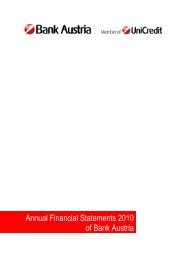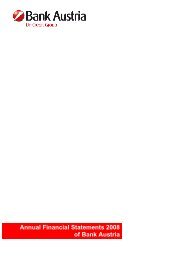Annual Financial Statements 2011 of Bank Austria
Annual Financial Statements 2011 of Bank Austria
Annual Financial Statements 2011 of Bank Austria
You also want an ePaper? Increase the reach of your titles
YUMPU automatically turns print PDFs into web optimized ePapers that Google loves.
Notes to the <strong>Financial</strong> <strong>Statements</strong> <strong>of</strong> UniCredit <strong>Bank</strong> <strong>Austria</strong> AG<br />
4.31. Derivatives business<br />
Derivatives shown in the following tables are classified<br />
as financial derivatives and credit derivatives,<br />
according to the underlying financial instrument. In<br />
these categories, a distinction is made between trading<br />
book and banking book and between different<br />
counterparties. UniCredit <strong>Bank</strong> <strong>Austria</strong> AG’s business<br />
volume in derivatives focuses on interest rate<br />
contracts.<br />
Over-the-counter transactions are individual<br />
agreements concerning volume, maturities and<br />
underlying instrument. In large-volume interbank<br />
trading, these agreements reflect international practice,<br />
while in customer business they are usually adjusted to<br />
specific needs. Exchange-traded contracts are always<br />
standardised in respect <strong>of</strong> volume and maturity date.<br />
Derivatives are mainly used by the bank itself for<br />
hedging market risk and credit spread risk arising from<br />
new issue activities. In customer business, market<br />
participants include banks, securities houses, mutual<br />
funds, pension funds and corporate customers.<br />
Trading in derivatives at <strong>Bank</strong> <strong>Austria</strong> is primarily<br />
related to the hedging <strong>of</strong> positions entered into vis-àvis<br />
customers.<br />
For the purposes <strong>of</strong> portfolio and risk management,<br />
contracts are valued at current prices using recognised<br />
and tested models. Market values show the contract<br />
values as at the balance sheet date, positive market<br />
values indicate the potential default risk arising from<br />
the relevant activity.<br />
For the purposes <strong>of</strong> portfolio management and risk<br />
limitation in the derivatives business with banks and<br />
customers, UniCredit <strong>Bank</strong> <strong>Austria</strong> AG uses a Monte<br />
Carlo path simulation to estimate the potential future<br />
exposure at portfolio level for each counterparty. The<br />
calculations are based on market volatility, correlations<br />
between specific risk factors, future cash flows and<br />
stress considerations. Netting agreements and<br />
collateral agreements are also taken into account for<br />
simulation purposes.<br />
The simulation calculations are performed for all major<br />
types <strong>of</strong> transactions, e.g. forward foreign exchange<br />
transactions, commodity futures transactions, interest<br />
rate instruments, securities lending transactions and<br />
repurchase agreements, equity-related, commodityrelated<br />
or inflation-related instruments and credit<br />
derivatives. Other (exotic) products are taken into<br />
account with an add-on factor (depending on volatility<br />
and maturity). The bank applies a confidence interval<br />
<strong>of</strong> 97.5%.<br />
In addition to determining the potential future exposure<br />
for the purpose <strong>of</strong> internal risk management, the path<br />
simulation also enables the bank to calculate the mean<br />
exposure and the Basel 2-modified mean exposure as<br />
well as the effective term <strong>of</strong> the exposure for each<br />
counterparty. In this way, counterparty risk can be<br />
taken into account in a Basel 2-compliant internal<br />
model for the calculation <strong>of</strong> capital requirements. In<br />
2009, the bank obtained approval from the <strong>Austria</strong>n<br />
regulatory authorities for the use <strong>of</strong> the relevant model.<br />
Line utilisation for derivatives business is available<br />
online in WSS (“Wallstreet”), the central treasury<br />
system, on a largely Group-wide basis. For smaller<br />
units not connected to the central system, separate<br />
lines are allocated and monitored. Group-wide<br />
compliance with lines approved in the credit process is<br />
thus ensured at any time.<br />
UniCredit <strong>Bank</strong> <strong>Austria</strong> AG additionally limits the credit<br />
risk arising from its derivatives business through strict<br />
use <strong>of</strong> master agreements, through collateral<br />
agreements and break clauses. In combination with<br />
the very good average credit rating <strong>of</strong> our business<br />
partners in the derivatives business, management<br />
takes proper account <strong>of</strong> default risk.<br />
Details <strong>of</strong> derivatives transactions and <strong>of</strong> the uniform<br />
Group-wide method <strong>of</strong> recording them for risk<br />
measurement and risk management purposes are<br />
given in the following tables.<br />
Information pursuant to Section 64 (1) 3 <strong>of</strong> the <strong>Austria</strong>n<br />
<strong>Bank</strong>ing Act may also be derived from the statistical<br />
data for derivatives.<br />
<strong>Bank</strong> <strong>Austria</strong> – <strong>Annual</strong> <strong>Financial</strong> <strong>Statements</strong> <strong>2011</strong> 226
















